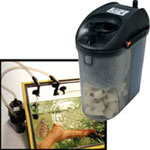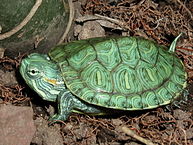Red Eared Sliders and other semi-aquatic and aquatic turtles have just about everything one could ask for in a reptile pet – fascinating behaviors, responsiveness, breeding potential, beautiful coloration and shell patterns and with proper care, the ability to outlive scores of dogs and other “lesser beasts”. But however how much we may enjoy them (and I know folks with collections numbering 100 to 2,000+!), keeping their water clean, both for clarity and health reasons, can be a frustrating and time consuming task. Today I’ll review some useful points to consider when deciding upon a filter. Please post your own experiences, thoughts, and questions below.
We turtle enthusiasts are fortunate to have available a huge array of different filters designed for use with turtles. But when you consider also the traditional fish filters that also suit turtles, the choices can be overwhelming. I favor the Zoo Med Turtle Clean (please see photo) for most species, but submersible models, basking site/filter combinations, hanging types and others are all useful in certain situations. Please post below for detailed information on your particular turtle and aquarium.
Ease of Maintenance
However well-intentioned we may be, filter media changes tend to be put-off if they take too much time and effort. This becomes ever more important as one’s turtle collection grows. If you think this may be a concern, consider filters that require mere seconds to maintain, such as the Tetra Whisper In-Tank Filter.
Spotted, Bog and other turtles adapted to slow-moving water bodies cannot abide strong currents in their aquarium; the same is true for hatchlings of nearly all species. An overly-powerful filter outflow can even be a source of stress to large Cooters and Map Turtles, many of which are good swimmers that inhabit large rivers.
Some filters, such as Zoo Med’s Turtle Clean and the Ovation Submersible, have spray bars that allow us to control the force and direction of the filter’s output. Rocks and other objects may be used to modify the outflow of other models.
Soft-shelled Turtles, young Common Snappers, Reeves Turtles and many others fare best when kept at a water depth that allows the head to break the surface without the need for swimming. Filters designed primarily for use with fish generally do not function in partially-filled aquariums. Fortunately, most hanging, canister, and submersible turtle filters will work in shallow water…as low as 2 inches in some cases.
Water Changes
Bear in mind that regular partial water changes will be necessary, even with powerful filters. In easily-serviced tanks, this fact has allowed me to use small, inexpensive filters which would not be sufficient if frequent water changes were difficult to carry-out.
Feed Outside of the Aquarium!
Removing your turtles from the aquarium for feeding is perhaps the most important step you can take towards easing both your own and the filter’s workload. Please see the article linked below for further information.
Eliminate Substrate Where Possible
Gravel and river rocks will add to the difficulties involved in keeping your water clear; impactions from swallowed substrate are also a concern. Chinese and other Softshells do best when a sandy substrate is provided, but most others can be kept in bare-bottomed aquariums. Regularly sweeping a brine shrimp net across the tank’s bottom will aid in maintaining water quality.
Consider Your Pet’s Size and Vigor
Turtles are very hard on filters, heaters and decorations, sometimes seeming to take a perverse pleasure in destroying our efforts on their behalf! Look into the size and power of suction cups, and how intake tubes attach to hanging filters, before making your decision. Please post below if you need information on specific models.
Use the Largest Enclosure Possible
Fish keepers learned long ago that larger aquariums are “more forgiving” of water quality mistakes than are small tanks. While there are many variables, the same holds true for turtles. Even if you keep small species, always provide them with as much space as is feasible. You’ll be able to use a more powerful filter, and water changes may be less critical…plus, you’ll improve your turtle’s quality of life and be treated to a variety of interesting observations.
Consider Outdoor Ponds
If weather and space (and finances!) permit, koi and goldfish ponds and filters are wonderful options. Nothing tops natural sunlight and an influx of insects in maintaining turtle health, and egg-deposition sites, almost impossible to include in aquariums, are easily arranged.
Further Reading
 That Reptile Blog – Reptile, Amphibian and Exotic Pet Care and Information
That Reptile Blog – Reptile, Amphibian and Exotic Pet Care and Information









Can I use two tetra whisper 40i filters for a 40 gallon breeder turtle tank?
thanks
Hi,
Yes, that would be fine in fact- the more filtration the better for turtles
-Josh